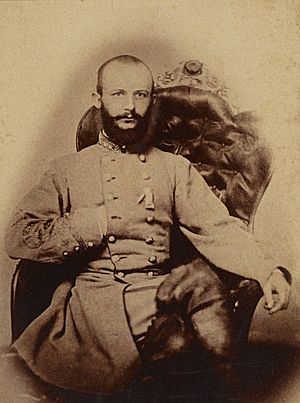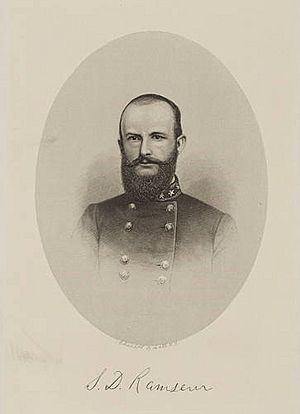Stephen Dodson Ramseur facts for kids
Quick facts for kids
Stephen Dodson Ramseur
|
|
|---|---|
 |
|
| Nickname(s) | Dod; Dodson Ramseur |
| Born | May 31, 1837 Lincolnton, North Carolina, U.S. |
| Died | October 20, 1864 (aged 27) Belle Grove Plantation, Middletown, Virginia |
| Place of burial |
Saint Luke's Episcopal Church Cemetery Lincolnton, North Carolina
|
| Allegiance | |
| Service/ |
|
| Years of service | 1860–61 (USA) 1861–64 (CSA) |
| Rank | Major General (CSA) |
| Unit | 3rd U.S. Artillery 4th U.S. Artillery 3rd North Carolina Infantry 1st North Carolina Artillery |
| Commands held | 49th North Carolina Infantry Ramseur's Brigade, II Corps, Army of Northern Virginia Early's Division, II Corps, Army of Northern Virginia |
| Battles/wars | American Civil War |
| Relations | Ellen "Nellie" Richmond (Wife) Mary Dodson Ramseur (Daughter) |
Stephen Dodson Ramseur (born May 31, 1837 – died October 20, 1864) was a brave general for the Confederate army during the American Civil War. He was even the youngest general in the army for a time!
He really impressed General Robert E. Lee with his actions in battles like Malvern Hill and Chancellorsville. At Chancellorsville, his group of soldiers, called a brigade, led a surprise attack. They faced many dangers but showed great courage.
At the Battle of Gettysburg, he helped push back Union soldiers through the town. Ramseur also fought well in the Overland Campaign and the Valley Campaign. He was badly wounded at the Battle of Cedar Creek, which led to his death.
Contents
Early Life and Education
Stephen Dodson Ramseur usually went by "Dod" or "Dodson." He was born in Lincolnton, North Carolina. His parents were Jacob Able and Lucy Mayfield Dodson Ramseur.
He was a second cousin to other future Confederate generals, John Horace Forney and William H. Forney. Ramseur went to Davidson College, where he studied math. One of his teachers was Daniel Harvey Hill, who also became a Confederate general.
Later, he attended the United States Military Academy (West Point). He graduated in 1860. Before the war started, he became a second lieutenant in the U.S. Army.
Joining the Civil War
Ramseur joined the Confederate States Army in Alabama even before North Carolina officially left the Union. He quickly moved to the 10th North Carolina Militia.
On May 27, 1861, he became a lieutenant colonel in the 3rd North Carolina Infantry. In July, he was thrown from his horse and broke his collarbone. This injury kept him out of action until the next spring.
Peninsula Campaign Battles
In 1862, at the start of the Peninsula Campaign, Ramseur was in charge of artillery. This was part of John B. Magruder's division. On April 12, 1862, he was chosen to be a colonel of the 49th North Carolina Infantry.
Ramseur saw his first major fighting at the Battle of Malvern Hill. He led a difficult charge against strong Union defenses. He was badly wounded in his right arm, which was left damaged and paralyzed.
He went home to recover from his injury. After the Battle of Antietam, he returned to lead a brigade of four North Carolina regiments. This group was part of Robert E. Rodes's division, under Thomas J. "Stonewall" Jackson.
On November 1, 1862, Ramseur was promoted to brigadier general. At just 25 years old, he became the youngest general in the Confederate army at that time. General Robert E. Lee was very impressed by Ramseur's brave actions at Malvern Hill.
Chancellorsville: A Key Battle
In the Battle of Chancellorsville on May 2, 1863, Ramseur's brigade led Stonewall Jackson's famous surprise attack. This attack hit the Union army's right side.
J.E.B. Stuart, who was temporarily in charge after Jackson was wounded, praised Ramseur's brigade. He even suggested Ramseur be promoted to major general. Ramseur's brigade fought very hard and had many soldiers wounded.
The next day, Ramseur was wounded again, this time in the leg. General Lee wrote about Ramseur's brigade, saying they were "among the best" and that Ramseur's actions were "especially commended."
Gettysburg: Pushing Back the Enemy
At the Battle of Gettysburg on July 1, 1863, Ramseur's brigade was part of an attack. They moved south from Oak Hill against the Union I Corps.
Ramseur's group started in reserve, but they were called forward when other attacks struggled. Instead of attacking directly, he moved his soldiers around to the left. They hit the Union defenders from behind, causing them to retreat through the town.
Ramseur was disappointed when he was told to stop chasing the enemy at the bottom of Cemetery Hill. This was his last fighting at Gettysburg. His division stayed quiet for the next two days. After the battle, Ramseur went home to marry Ellen E. "Nellie" Richmond. They spent three months together at the army's winter camp.
The Wilderness and Spotsylvania
The Battle of the Wilderness in 1864 marked the start of Ulysses S. Grant's Overland Campaign. Ramseur's brigade was held in reserve again. On May 7, 1864, his brigade was sent forward. They crashed into Ambrose Burnside's IX Corps.
Ramseur's attack pushed Burnside's troops back over half a mile. Both General Lee and Richard S. Ewell praised his brave attack. At Spotsylvania Court House, his brigade counterattacked after a Union assault.
There was intense hand-to-hand fighting that lasted over 20 hours. Ramseur was wounded again in this attack, shot from his horse in the right arm. But he refused to leave the battlefield.
Promotion to Major General
After Spotsylvania, Ramseur took command of Jubal A. Early's division. He received a temporary promotion to major general on June 1, 1864. At 27, he became the youngest West Point graduate to become a major general in the Confederate Army.
He fought at Cold Harbor. His division was the first to stop Grant before he could capture Petersburg.
1864 Valley Campaign and Final Battle
In June 1864, Ramseur's corps was sent to the Shenandoah Valley. This was to draw Union forces away from Petersburg. They raided down the Valley, into Maryland, and even reached the edge of Washington, D.C..
Later, Philip Sheridan was sent by Grant to push Early out of the Valley. On September 19, 1864, Sheridan attacked at the Battle of Opequon. Ramseur's division was defeated by a strong Union attack. Ramseur was very upset and blamed his men for the retreat. His friend and colleague Rodes was badly wounded and died.
A month later, at the Battle of Cedar Creek on October 19, Early's army surprised and defeated much of the Union army. But his troops were tired and hungry. They stopped fighting to take supplies from the Union camp.
Ramseur managed to gather a few hundred soldiers from his division. They stood in the center of the line as Sheridan counterattacked. They held off the Union attack for an hour and a half. Ramseur showed great bravery, but he was riding his horse and drew a lot of enemy fire. He was wounded in the arm, and his horse was shot. A second horse was also killed. On his third horse, he was shot through both lungs and fell. Union soldiers captured him.
Dodson Ramseur died the next day, October 20, 1864, near Middletown, Virginia. He was at Sheridan's headquarters in the Belle Grove Plantation. His last words were, "Bear this message to my precious wife—I die a Christian and hope to meet her in heaven." The day before the battle, he had learned that his baby daughter was born.
He is buried near his birthplace in Lincolnton, North Carolina, at St. Luke's Episcopal Cemetery.
Jubal Early wrote about Ramseur after Cedar Creek: "He was a most gallant and energetic officer whom no disaster appalled... He fell at his post fighting like a lion at bay."
Legacy and Remembrance
The town of Ramseur in eastern Randolph County, North Carolina is named in his honor.
A monument on the Cedar Creek battlefield remembers Ramseur's death at the Belle Grove House.
In Popular Culture
In MacKinlay Kantor's 1961 book If the South Had Won the Civil War, Ramseur is a character. He works to end slavery in an independent Confederacy.
In Ralph Peters's 2015 book "Valley of the Shadow," General Ramseur is an important character. The book is about the Valley Campaigns of 1864.
See also


